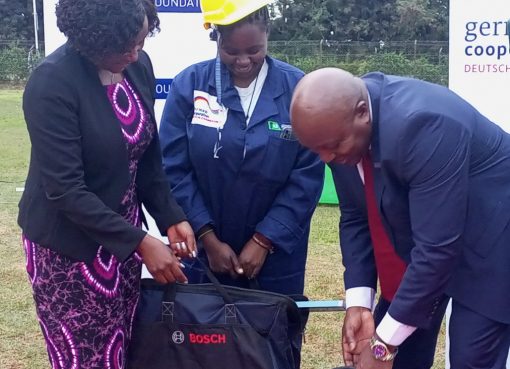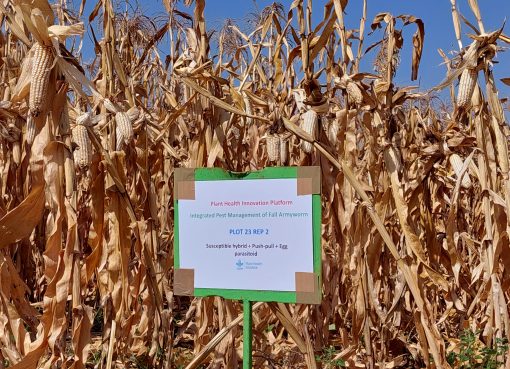Farmers have been urged to adopt Good Agricultural Practices (GAP) for tomato production in order to ensure quality and safe produce for the consumers in addition to safeguarding the environment.
Tomato is the second most important exotic vegetable that is widely consumed in Kenya, and its production constitutes one of the fastest growing markets edging towards a vital cash crop.
Cases of excessive use of pesticides have always been reported with the agro-chemicals used by farmers having been banned by the government but they still find their way into the farmers’ fields.
Kenya Agricultural Livestock Research Organisation (KALRO) Director General, Dr Eliud Kireger, says that excess use of pesticides without observing the post-harvest intervals (PHI), leads to the tomatoes accumulating high residues of the chemicals thereby slowly affecting the consumers of the tomatoes and tomato products.
“The high incidents of chronic diseases being experienced in the country are partly contributed by the excessive use of agro-chemicals thus it is important for farmers to adopt and practice the safe tomato production practices,” the DG said during a farmers’ field day at Rombo in Kajiado County under the Kenya Climate Smart Agriculture Project (KCSAP) programme.
Dr Kireger said KALRO has continued to develop technologies, innovations and management practices for crops and livestock in a bid to ensure food and nutrition security and increased incomes for farmers countrywide.
These efforts, he however said, can only bear fruits if all stakeholders work together not as competitors but in a complimentary manner since all are serving the same farmer.
The DG noted that several improved tomato cultivars that are high yielding, and resistant to pests amongst other attributes have been developed to enhance tomato production.

However, he added that most smallholder farmers do not use the varieties due to lack of information on the right varieties suitable for specific production systems and best agronomic packages in specific agro ecological zones especially in the arid and semi-arid areas.
Poor postharvest handling and limited value addition he added, also cause high price fluctuations and postharvest losses, while poorly organised urban and rural markets and poor infrastructure, also lead to price fluctuations leading to a decline in production and productivity.
“The average yield of tomato in Kenya stands at 15 tons per acre against a potential of 30-35 tons and this yield gap is as a result of various factors including biotic and abiotic stresses which include pests and diseases causing yield losses of up to 100 percent and this will require application of agrochemicals as the main control strategy,” he said.
Dr Kireger noted that the collaboration between KALRO,KCSAP and Kajiado County to organise the field day was to ensure farmers were sensitised on the availability of tomato varieties , demonstrations of various aspects of tomato production that include; appropriate agronomic practices; pests and disease control; safe use of agro-chemicals; proper harvesting and post-harvest handling of the tomato fruit as well as value addition and marketing.
He explained that a baseline survey conducted within Kajiado County revealed that farmers were facing several challenges along the tomato value chain that needed to be addressed and also required the different stakeholders to be involved.
The major tomato producing counties in Kenya are Kajiado, Kirinyaga, Taita-Taveta, Laikipia, Bungoma, and Trans-Nzoia with the production volume of tomato in the country currently standing at 574,458 metric tons and earning the country about Sh20 billion from an area of 28,263 hectares.
Moses Murunya , the Chief Officer Agriculture and Fisheries in Kajiado County, acknowledged that farmers in the Rombo area which is currently the highest producer of tomatoes in the country, has been facing challenges in terms of production of tomatoes, in soils, capacity to produce optimally due to seeds and also in market accessibility.
“Our main market is Mombasa and the County Government is trying to address the challenge of access to markets through the establishment of a factory that is being built by the Ewaso Nyiro Development Authority,” he said.
Murunya said that once complete, the factory will address the issue of glut when it comes to excess production or even due to poor markets as it will invest in value addition, and this will automatically address the farmers’ post-harvest losses they have been incurring.
“Value addition is the greatest solution to the glut and excess production and even production that does not go anywhere due to transport and exit point challenges,” he said, noting that apart from creating employment, money readily for farmers, revenue for the county, there will be improvement use of all by products for use for livestock feeds once the factory is up and running.
Jane Njeri Mwangi from Rombo area and who moved from Kiambu County 10 years ago to farm tomatoes said the technologies being brought by KALRO to the farmers are welcome and timely as most of them have been suffering from lack of good seeds, and pesticides when it comes to production of tomatoes.
Tomato production is estimated to contribute more than Sh15 billion annually to the Kenya economy, supplying income to the producers and food to the country’s population.
The Government has been striving to achieve national household and individual food and nutrition security to address the inaccessibility to food which is closely linked to poverty which stands at 46 percent nationally.
The initiative to attain food and nutrition security is anchored in the Kenya Climate Smart Agriculture Strategy (2017–2026) that envisions a climate resilient and low carbon growth sustainable agriculture that contributes to the national development goals in line with Kenya’s Vision 2030.
By Wangari Ndirangu




